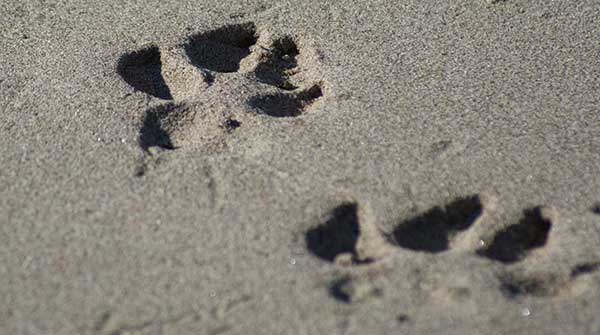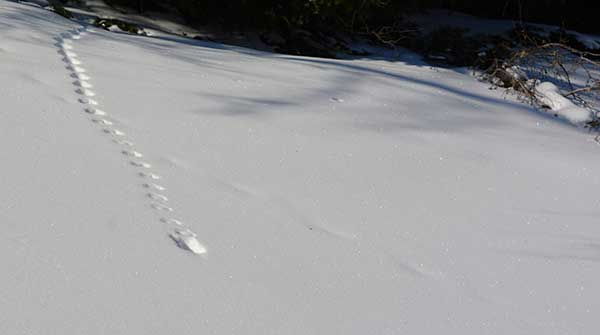Animal tracks can tell what the animal was doing, but identifying the tracks can be tricky
 We often see animal tracks but do we really know the story they’re trying to tell us? There are lots of clues to watch out for.
We often see animal tracks but do we really know the story they’re trying to tell us? There are lots of clues to watch out for.
Let’s look at a few of them.
Animal tracks are easy to detect but not always easy to identify. All mammals and birds can and will leave tracks in the snow as they go about foraging for food. These tracks can tell much about what the animal was doing, but identifying the tracks can be tricky.
You need to consider the possible species, habitat, the size of the track, the pattern, the length of the stride and more. If it is a quadruped (four-legged animal), you will see four prints, but don’t always assume that the front two come from the front feet as many animals swing their hind legs in front of the forepaws when travelling.
 Canid tracks  Grouse tracks |
| Related Stories |
| Birdwatching in Honduras – plumage aplenty
|
| Breeding bird study offers insights into health of the environment
|
| The slow, subtle arrival of spring brings nature alive
|
Many good books, such as Peterson’s A Field Guide to Animal Tracks, can help identify what you see. Several phone apps are also available to assist you. Search on ‘animal tracks’ in your app store. Two I have used are Google Lens and iNaturalist which does way more than just identify animal tracks. iNaturalist will also help with plant, insect, animal ID, and much more!
Now how do you go about figuring out what you saw?
I like to take photos of what I observe if I’m unsure of the species, and, sometimes, I make field notes and then take those home to do my research. I don’t simply upload them to an app and ask someone else to identify them because I don’t learn that way. But once I’ve exhausted my resources and still can’t figure it out, I will post on something like iNaturalist or a nature club’s Facebook page and ask for an expert to help. Naturalists, such as those in a local nature club, are very generous with their time and will usually freely assist.
Okay, so now that you’ve figured out what you saw, why not spend a bit of time deciphering what they were doing?
If you see complex overlapping tracks in a small area, then presume that many critters were there for some longer period of time feeding. Birdfeeders are a great spot to see this type of activity. A single track leading off into the distance might indicate a coyote or fox wandering through its territory looking for food.
Were there two sets of tracks paralleling each other? Perhaps a pair of foxes was travelling together – mates or siblings will do this. But what if the track suddenly ends with no indication of where the animal went? Several things could be happening here. It could be a bird that just flew away, or maybe an aerial predator grabbed it for lunch, or maybe it’s still there! Ruffed Grouse will roost under the snow on cold nights, so maybe our mystery bird just burrowed into the snow. If you’re lucky, you will know if this is true as it will explode out of the snow at your feet.
A change in the length of the stride usually indicates that something startled the animal. A car or predator or even one of us can force them to flee, and the length of the stride will clearly show that.
Is there a bird wing pattern on the fresh snow? This may indicate several things, but foremost it tells us that a bird landed or took off from that spot. It generally only works well on fresh snow; often, a beautiful imprint of most or all of the wing feathers can be seen. The bird may have been landing in deeper snow so its wing touched the ground, or a predator was swopping in and using its wings for balance.
Well, that’s a start for now. I will continue the exploration of animal signs and how to read them another time.
Geoff Carpentier is a published author, expedition guide and environmental consultant. Visit Geoff on LinkedIn, Instagram and Facebook.
For interview requests, click here.
The opinions expressed by our columnists and contributors are theirs alone and do not inherently or expressly reflect the views of our publication.
© Troy Media
Troy Media is an editorial content provider to media outlets and its own hosted community news outlets across Canada.


